FRENCH WINE LAWS AND CLASSIFICATIONS
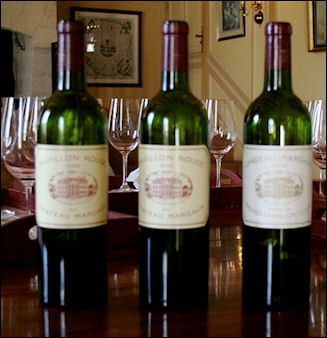
Chateau Margaux wines France has the world's strictest wine laws. Adding wines other than what its listed on the label is prohibited (by contrast only 25 percent of the wine in a bottle of American wine has to be what is one the label). Adding additives is also tightly regulated. Adding sugar or acids to increase or decrease the alcohol — a practice very common outside of France — is allowed but within narrow limits. Adding another wine is particularly frowned upon. Even thought wineries are occasionally charged with doctoring the wine, it believed that the roles are largely flaunted.
The best way to chose a good French wine is to ask someone you can trust or follow the wine French government’s classification system which define four categories of wines: 1) “Vin de table” (or “vin ordinarie” ); 2) “Vin de Pays” ; 3) “Vin Délimité de Quality Supérieure”; and 4) “Appellation d'Origine Contolée” .
“Vin de table” must have an alcohol level of at least 9.5 proof and meet other minimum standards. Many are blends of wines, including wines from Italy or North Africa. There are good vin de tables but finding them is a hit or miss process. Vin de Pays” are produced under stricter conditions. They must be produced in a specific geographical area and meet specific standards that were set in 1964. The alcohol content requirements vary from north or south. The designation was intended to boost the production and consumption of lesser known regional wines.
“Vin Délimité de Quality Supérieure” (V.D.Q.S.) are top quality wines that meet almost the same standards as those for the more prestigious A.O.C. wines. There are about 60 V.D.Q.S. wines. “Appellation d'Origine Contolée” (A.O.C. or A.C.) are considered France 's best wines. The regulations and restriction on geographical area, grapes and process are strict and set to ensure the highest quality. As a rule the more specific and smaller the geographical area the better the quality. Wines with a single chateau or domaine listing on their
label are generally the best. 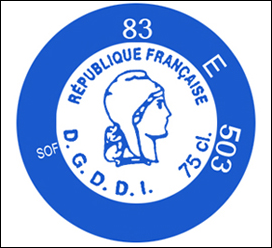
Websites and Resources: Guardian & Observer Guide to Wine guardian.co.uk/lifeandstyle/page ; Wine Anorak wineanorak.com ; Wine Spectator winespectator.com ; Wine.com wine.com ; Wikipedia article Wikipedia ; Tesco Wine tesco.com/wine ; Wine Types wineintro.com/types/ ; Types of Wines lovetoknow.com/wiki/Category:Types_of_Wine ; Types of Wine Grapes frenchscout.com/types-of-wines ; History of Wine winepros.org/wine101/history ; Wikipedia article on History of Wine Wikipedia ; History of Wine Cornell University /rmc.library.cornell.edu/ewga/exhibition ; Winemaking wineintro.com/making ; Wine Producing madehow.com ;
Books: “Pocket Encyclopedia of Wine” by Hugh Johnson (Simon and Schuster) and “Oxford Companion to Wine” edited by Jancis Robinson (Oxford). Robert Parker, editor of the Wine Advocate, is author of several authoritative books on French wines.
Wine Regions
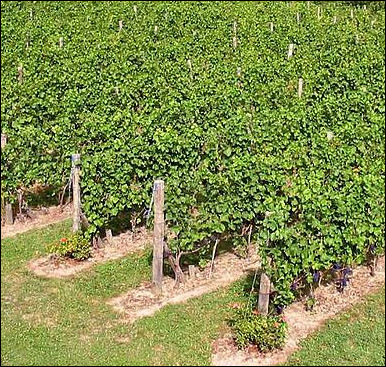
vineyard in St-Germain near Paris Although wine is grown throughout France, seven regions are most well known: 1) Champagne, 2) Burgundy, 3) Alsace, 4) Val-de-Loire (from Nantes through Touraine to Central France), 5) Bordeaux and the Cognac, Armagnac and Béarn areas; 6) Côtes du Rhône; 7) Langue-doc-Roussillon.
Bourogne is known as the "king of wines." The wines grown in this region are made from one grape variety. Bordeaux "the queen of wines." The wines are made from a blending of select wines. Cote du Rhone is famous for its fine red wines; Provence is known for its rosés. Good French wines are also produced in Provence, Quercu (Cahors), the Jura, Corsica and Auvergne.
Dr. Jason West of the University of Utah has developed a way to determine the point of origin of wine by measuring the ratios of stable hydrogen, nitrogen, carbon and oxygen isotopes found in the leaves. The ratios of stable hydrogen isotopes, for example, can be matched to the local water in a particular region with the same ratio. West can also determine other things like whether the grapes was grown inside or outside, what fertilizers are used and amount of rain and sun suing nitrogen and carbon isotopes.
Bordeaux Wines
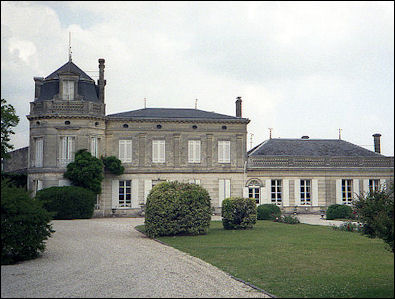
Chateau Chasse-Spleen in the Medoc area of Bordeaux Bordeaux Wine Country, a region of 250,000 acres located within a 50 mile radius of the city of Bordeaux, is the greatest wine growing region in the world in terms of both quality and quantity. Most of the gear wineries are located north and west of Bordeaux on a peninsula flanked by the Atlantic Ocean and Gironde River. About a third of France's wines have traditionally come Bordeaux.
Bordeaux's most celebrated chateaus produce red wine. But the fruity white wines from the region are also quite good. Some wines even have a hint of an apricot flavor. Exceptional reds from Bordeaux include vintages produced in 1966, 1970, 1975, 1981, 1982 and 1983. Very good ones were made in 1967, 1971, 1976 and 1978. Good: 1973, 1974, 1979 and 19 84. Exceptional white Bordeaux include vintages produced in 1965, 1975, and 1982. Very Good: 1970, 1971, 1979, 1981 and 1983. Good: 1974, 1976, 1978 and 1980.
The rate of production in Bordeaux varies from year to year but is usually between 500 million to a billion bottles of wine. You don't have to be a mathematical genius to realize that this also adds up to a lot of money. In a typical year Bordeaux produces about 850 million bottles of wine, about the same amount it produced several decades ago. Bordeaux exports much of the wine it produces.
The largest wine producing areas in Bordeaux are Medoc, Haut Medoc, Graves, Sauternes, Blayais and Entre-Duex-Mers, but there are many other small areas as well. Medoc is far and away the most famous region and equally famous is its classification system, established in 1855, which rates wines into first, second, third, forth and fifth growths (crus). Most of the other great wines are reds from the gravely soils on the south side of the Garonne river. One Sauternes, a sweet white wine, merits a premier crus rating. The grapes from this vineyard are picked one by one when they are on the verge of rotting to get the perfect concentration of sugar, 20 percent.
Medocs and Margaux, St.-Jullien and Paulliac (the home of Chateau Latour). are considered the best. Pomerol, St.-Emilion, Graves, Entre-Deux-Mers, Cadillac, Cotes de Bourgs are considered great. "Every wine lover's idea of heaven" is how connoisseur Hugh Johnson described Saint-Émilion. "Nowhere is the...life of a little city so deeply imbued with the passion for making good wine."
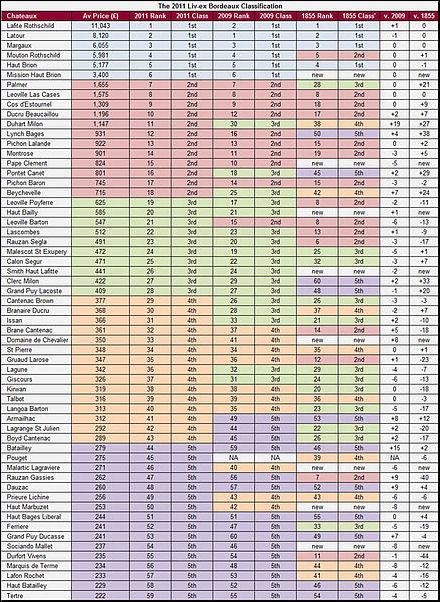
2011 Liv-ex Bordeaux Classification
As of the mid 1990s, 1971 and 1982 were excellent Bordeaux years. More affordable good years are 1989 and 1990; 1991, 1992 and 1993 were mediocre. For Bordeaux whites, 1987 was a bad years, 1983 and 1986 were good for drinking now and 1989 and 1990 are good after storing for a couple of years.
Premier Bordeaux Wines
Only five wines are considered” premiers crus” ("great growth"): Château Lafite, Château Latour, Château Mourton-Rothchild, Châteaux Margaux and Château Haut-Brion. Of these five only one — Chateau Mourton-Rothchild — was not on the original 1855 list and it took a 20 year battle by Baron Phillipe de Rothchilde to get his win place there in 1973. These wines are famous for their deep, resonant style.
Lafite and Moulden are owned by the Rothchild banking family. They produce some of the world's greatest and most expensive wines. The British wine critic Hugh Johnson wrote: "Lafite is tenor, Latour is bass; Lafite is lyric, Latour an epic; Lafite is a dance, Latour a parade."
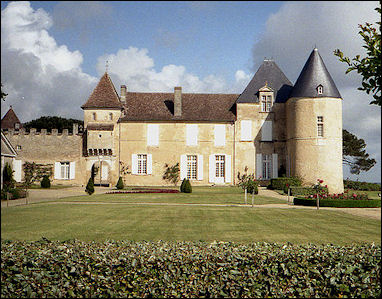
Chateau dY'quem In the classic 1855 rating of great wines, 21 or the 61 top wines came from the Margaux region. "Margaux wines,” wrote the late Alexis Lichine, owner of Château Prieure-Lichine, "constitutes a royal family." The Marguax regions is made of land surrounding five towns.. In 1954, a strict designation was made of what constitutes and what doesn't constitute a Margaux
wine.
Château d'Yquem is another famous chateau. It has been producing one of France's best wines — the sweet white Sauternes since 1785, when Thomas Jefferson and many other famous people were among its admirers. The chateau encompasses only 272 acres of land. Yquem has been described as the world's best sweet white wine. One of Jefferson's bottles of Yquem was sold in 1987 for $56,000. A bottle of Yquem '21 was sold at the Caves Taillevent restaurant in Paris for $4,300 in the 1990s.
In 1997, case of 12 bottles of 1945 Chateau Mounton-Rothchild was sold for 532,000 francs. One single bottle of 1806 Chateau Lafite once fetched $28,000 at a Chicago auction. In 1997, $107,000 was paid for six bottles of 1945 Chateau Mouton-Rothschild. The most expensive wine was a bottle of 1787 Château Lafite claret with Thomas Jefferson's initials engraved on it sold at a Christie's auction in London in 1985 for $131,240 a bottle. It is said that 45, 47 and 48 Yquem’s are the best wines ever produced.
Burgundy
Burgundy is a large, sparsely populated region known for its wine and its lovely countryside. The famous wines where first developed in Medieval times by monks who planted the early vineyards to make wines for religious ceremonies. Today there are 46,000 wine growers, and 5000 separate vineyards that cover over 210 square kilometers. Most of Burgundy's vineyards and farms lie on the rolling hills, that interspersed with forests, canals, and quaint villages.
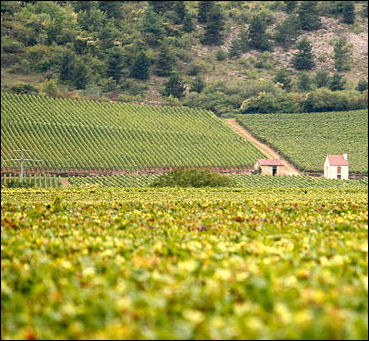
Burgundy The Major Wine Growing Regions of Burgundy include Chablis in the northern part of the province; Cote Chalonnaise, Cote de Nuits and Cote de Beaune south of Dijon; and Beaujolais and Maconnais in the south of the province.
About 15 percent of France's wine come from Burgundy compared to 33 percent from Bordeaux. The Burgandians consider themselves much more down to earth than their brethren in the southwest and their wine making process is much simpler as well.
Unlike Bordeaux which makes wine from a complex blend of grapes that takes many years to mature Burgundy wines are essentially made from three different kind of grape: Pinot Noir grapes for red wine, Chardonnay grapes for white wine and Gamay grapes for Beaujolais, all of which have a very short vinification time. The less important wines are ready in three years and the important wines are ready in five.
Burgundy's best and most famous wines — Pommard, Meursalt, Volnay, Clos de Vougeot, Chambertin, Romanee-Conti and Montrachet — all come from the Cote d'Or region of Cote de Beaune. They are named after the villages and vineyards that produce them. The great Chardonnays of Burgundy have a distinct structure and acidity. These days Chardonnays are regarded as tasting pretty much all the same.
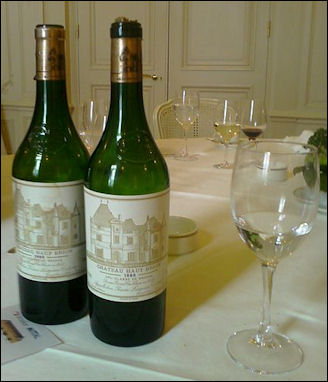
Exceptional reds from Burgundy include vintages produced in 1969, 1976, and 1978. Very Good: 1966 and 1971. Good: 1970, 1972, 1979, 1982 and 1983. Very Good whites from Burgundy include vintages produced in 1969, 1970, 1976, 1978, 1970 and 1982. Good: 1966, 1967, 1971, 1973, 1974, 1981 and 1984.
Beaujolais
Beaujolais is a fruity, flowery young wine that comes from Beaujolais, a huge sunny region of southern Burgundy perfect for growing grapes, that produces up to 150 million bottles a year of a wine that only takes a year to mature. Beaujolais is France's most popular red wine. The day it is shipped out is an important day, not only France but worldwide. Some of the first shipments are placed on planes bound for Japan where they like many Frenchman are curious to find out what this year's Beaujolais is like.
According to French law, Beaujolais nouveau cannot be sold until 12:01am on the third Thursday of November. That is when it has traditionally been loaded onto trucks and raced to Paris so that the new Beaujolais was ready to be sold when stored open in the morning. Connoisseurs thump their nose at Beaujolais but even so it generates tens of million of dollars in business.
The Beaujolais harvest usually takes place in mid September and rainfall and temperature patterns during the summer and the harvests season are important on determining of that year's vintage. The quality of Beaujolais is judged by color, aroma and balance. The taste can be fruity, mild or strong, often determined by the amount of tannin and acid. Describing the 1994 Beaujolais, the wine critic for Le Figaro, Françous Simon, wrote "It is frank, direct, less acidic. It laughs but does not smile. It pleases but does not flatter. It is a joker but not a gigolo."
Champagne
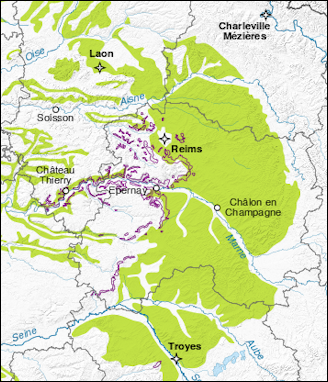
Champagne region By definition champagne is a sparkling wine that comes from Champagne, a province in northern France not far from Belgium and Germany. About a half of all true champagne sold is sold in France, where is most often served as an aperitif. There are an estimated 1 billion bottles of champagne stored in French cellars. Sparkling wines are also produced in Spain, Germany and the United States.
If you have always thought that champagne gives you a quicker, happier buzz you may be right. Champagne is more intoxicating than still wines because the carbon dioxide gas rushes the alcohol into the small intestine where it is absorbed faster than in the stomach. The carbonation also makes it easier for the bloodstream and brain to absorb the alcohol.
Champagne was created around 1680 by someone who opened a bottle of wine, saw it fermenting and then recorked it, and then reopened it and recorked it again. When it was opened a third time it was champagne. The discovery is usually attributed to the blind monk and winegrower Dom Perignon (1638-1715). It is said he exclaimed "I'm drinking stars!" when he invented champagne by accident while trying to make white wine. According to the Guinness Book of Records, the world's oldest champagne vintner is Ruinart Père et Fils. It was founded in 1729.
For many years the French looked down on champagne. The English were the ones who liked it, particularly dry champagne, and were the world's leading consumers of it for more than two centuries. Winston Churchill, a great lover of champagne, once said, "In victory I deserve it, and defeat, I need it."
Making Champagne

Champagne is made from a blend of three grapes — Chardonnay, Pinot Noir and Pinoy Meunier — from multiple harvest years. It gets its fizz from the fact it is fermented a second time inside the bottle when a final drop of sugar is added.
At the Champagne Pommery in Rheims grapes from seven nearby villages are harvested and blended and fermented in vats, bottled and then deposited in cellars for three to six years, during which time the second fermentation takes place. The bottles are stacked on racks and periodically rotated by hand and tilted downward.
After the second fermentation is completed the neck of the bottle in frozen and the champagne is uncorked and gases push out the sediment-laden ice, leaving behind clear champagne. Sometimes some sugar and more wine is added and the bottle is the properly corked.
In the 19th century, La Grand Dame Clicquot, invented the "riddling rack" which is still used to tilt Champagne bottles upside down as they approach the end of their aging process, so that the yeast sediments that have collected around the cork can be popped out before the bottles are recorked for the last time.
The wine for champagne was traditionally stored in oak vats. But an increase in demand for champagne after World War II encouraged many champagne makers to start using stainless steel containers for the first fermentation. Today computers and chemical systems are employed. Temperature and air flow into the cellars is controlled by opening and shutting windows.
Proper Champagne Drinking

Dom Perignon champagne When opening a champagne bottle, keep constant downward pressure on the cork while unwinding the ring around he neck. Ease the cork out while twisting it from side to side. Though less dramatic than the "ballistic method," this technique helps the champagne retain its effervescence.
Don't let the champagne bottle get too cold. Champagne experts assert that excessively chilled champagne tastes acidic and has no scent. Thirty-five minutes in refrigerator or 15 minute in a freezer is considered adequate.
Only use hot water to clean your champagne glasses. Even small amounts of soup will cause a champagne to lose its fizz. Long, narrow flue- or tulip-glasses are better than broad, shallow glasses, which have a larger surface area and allow the effervescence to escape.
In the 1990s Frenchman Jacques Pitoux invented a cork that doesn't explode out of the champagne bottle when the bottle is opened. His mushroom shaped cork has a tab that uncovers a small hole when pulled, releasing the gas in the bottle. The tab also squeezes a belt on the cork which allows it to be slipped out of the bottle. Most champagne drinkers feel that such a cork could ruin the fun of opening a bottle of champagne, but a couple of small champagne houses decided to try it on a few thousand of bottles of champagne.
Kinds of Champagne
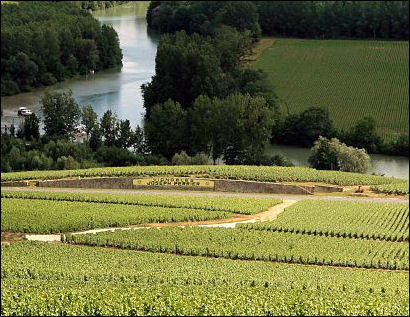
Champagne vineyards Champagne is "assembled" to create distinctive varieties, including cuvées (premium champagnes), bruts (dry wine champagne), different kinds of dry and sweet varieties and Jeroboams and Methuselahs. Bruts are the bestselling variety.
Unlike wines, champagnes are executed to a recognizable house taste each year. But each year the taste varies somewhat according to the crop and weather conditions. Unlike premium wines, only a small proportion (15 percent) of champagne is vintage, or dated, wine.
Well-known champagne producers include Moet & Chandon, Taittinger, Krug, Veuve Clicquot Ponsardin, Perrier-Jouet, and Piper Heidsieck. Moet & Chandon produces the best selling champagnes. It is owned by Moet Hennessy Louis Vuitton (LVMH), the luxury good conglomerate.
Good champagne values include: Delamotte Père et Fils Champagne Le Msnil-sur-Oger Blanc de Blance Brut ($34); Bollinger Champagne Special Cuvée Brut ($27); Pol Roger Champagne Brut ($30); Ayala Champagne Brut 1989 ($33); Pierrer-Jouet Champagne Cuvée Blason de France ($40); Henri Germain Brut ($26).
The French like pink champagne. Nicilas Feullatte is regarded as one of the best values. Veuve Clicquot is a common gift.
Prestige Champagne

Dom Perignon 1999 The best champagnes are called Tete de Cuvee or Cuvee de Prestige. They are often sold with their vintage years listed. Great vintage years included 1978, 1983 and 1988. A bottle of Cuvée Dom Pérignon 1988 sold for $250 in New York in 1999.
Dom Pérignon is not the same kind of champagne that the monk invented. It is the name chosen Moët et Chandon for its most expensive line of champagnes.
Krug champagne is more expensive that most brands because the first fermentation takes place in oak casks and the champagne is aged longer (six to seven years). Krug ages well and even vintages produced 75 years ago are drinkable. Krug produces about half a million bottles a year. The business is family owned the original Krug family which came to France from the Rhine valley in Germany in 1830.
Recommended Expensive champagnes include Cuvée Dom Pérignon ($100) and Krug Champagne Grande Cuvée ($95). Describing Cuvée Dom Pérignon 1992, Michael Franz wrote in the Washington Post, "A beautiful semaless wine with uncanny balance and integration. Complex, complete and utterly convincing. Equal to its reputation. Absolutely!" Describing a Krug 1989, Franz wrote, "Big, rich and soft, but also very powerfully flavored. A Perrier-Jouet Fleur 1995 he said "staked its claim on frothy freshness and an ethereal grace rather than power." He called the Pol Roger Brut Chardonnay 1990 "a stunning, virtually perfect wine” with "elegance but also an astonishing depth of flavor and creamy textural richness."
Champagne Industry
The quality and quantity of Champagne business is controlled by French government regulations and longstanding cooperative arrangements between Champagne producers.
About 270 million bottles of champagne were sold each year worldwide during the later 1990s, about 50 million more a years than in the recession-marked early 1990s. A record 300 million bottles was sold in 1999, much of purchased for year 2000 celebrations. Hundreds of millions of bottles of other sparkling wines are also sold every.
Around 150 million bottles worth of reserve wine, or about 20 percent of the harvest in a good year, is kept in storage so champagne cane be made in years when there is bad harvest.
In anticipation of rise of demand for champagne for year 2000 New Year's Eve party champagne producers began producing grapes and stockpiling wine in the early 1990s. In 1998, the began bottling it and selling it.
A group of vintner from the Champagne region of France won a legal suit against Yves Saint Laurent, banning him from marketing a new perfume called "Champagne."
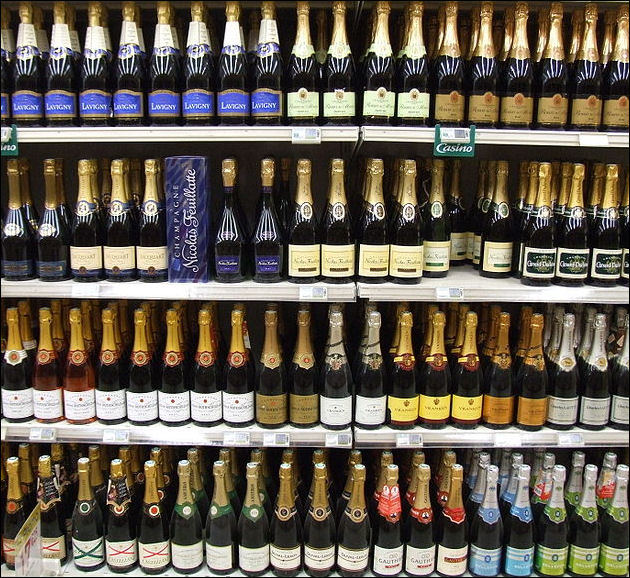
different kinds of champagne
Image Sources: Wikimedia Commons
Text Sources: National Geographic, New York Times, Washington Post, Los Angeles Times, Smithsonian magazine, Natural History magazine, Discover magazine, Times of London, The New Yorker, Time, Newsweek, Reuters, AP, AFP, Lonely Planet Guides, Compton’s Encyclopedia and various books and other publications.
Last updated March 2011
